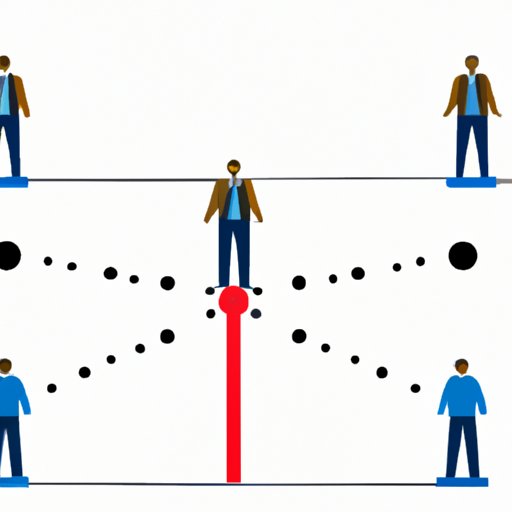Introduction
High power distance culture is a type of cultural orientation where there is a marked difference between those in positions of power and those who are not. This can manifest in a range of ways, from unequal access to resources, to varying degrees of respect or deference given to individuals based on their relative power or status. It is important to note that high power distance does not necessarily equate to oppressive behavior, but it can lead to an environment where power dynamics are more pronounced and hierarchical structures are more rigidly enforced.
In this article, we will explore the challenges associated with high power distance cultures, its impact on interpersonal relationships, organizational performance and employee engagement, as well as strategies to overcome such challenges.
Exploring the Impact of High Power Distance Cultures on Interpersonal Relationships
When examining the impact of high power distance cultures on interpersonal relationships, it is important to consider the role of hierarchy and the implications for communication. Hierarchy plays a significant role in high power distance cultures, with those in positions of power expected to be respected and deferred to by those in lower positions. This can lead to a situation where communication is less open and direct, as people may be hesitant to express dissenting views or challenge existing norms.
The effects of high power distance on communication can also be seen in the way language is used. For example, those in higher positions may use language that is more formal and indirect, while those in lower positions may be expected to use more polite and respectful language. In addition, high power distance cultures may place more emphasis on non-verbal communication, such as body language, gestures and facial expressions.
It is also important to examine the role of authority and power in high power distance cultures. Those in positions of power are typically viewed as having greater authority and influence than those in lower positions, and are often the ones making decisions. This can lead to a situation where those in lower positions may feel powerless or unable to contribute, which can create a sense of frustration and resentment.

Examining the Consequences of High Power Distance for Organizational Performance
When considering the consequences of high power distance for organizational performance, it is important to analyze the impact on leadership and management. High power distance cultures tend to place greater emphasis on hierarchical structures and traditional roles, which can lead to a lack of innovation and creativity, as well as difficulty in adapting to changing circumstances. This can have a negative impact on organizational performance, as it can limit the ability of leaders to make informed decisions and respond quickly to changing conditions.
In addition, high power distance cultures can shape social norms and values in a way that can be detrimental to organizational performance. For example, inequality may be accepted as the norm, leading to a situation where those in lower positions may be discouraged from speaking up or challenging existing structures. Similarly, those in higher positions may be reluctant to delegate tasks or empower others, leading to an inefficient allocation of resources and a lack of accountability.
Finally, it is important to consider how power distance can affect decision-making. Those in higher positions may be more likely to make decisions unilaterally, without consulting those in lower positions. This can lead to a situation where decisions are made without adequate consideration of potential risks or alternatives, resulting in poor outcomes and a lack of trust in the decision-making process.

Investigating the Impact of High Power Distance on Employee Engagement and Motivation
When exploring the impact of high power distance on employee engagement and motivation, it is important to understand the implications for diversity and inclusion. High power distance cultures tend to foster a homogenous workforce, as those in higher positions may be less likely to recognize the value of different perspectives or experiences. This can lead to an environment where employees feel excluded or undervalued, resulting in low morale and a lack of commitment.
Similarly, high power distance can have a negative effect on employee motivation. Employees may feel powerless or unimportant, leading to a lack of enthusiasm or initiative. Additionally, those in higher positions may be less likely to listen to feedback or take into account employees’ opinions when making decisions. This can lead to a situation where employees feel their efforts are not appreciated or valued, resulting in reduced motivation and productivity.
Finally, it is important to investigate strategies to overcome the challenges associated with high power distance. This includes creating an environment where everyone’s opinion is valued and respected, promoting open and honest communication, and encouraging collaboration and teamwork. Additionally, leaders should strive to create an atmosphere of trust and respect, where employees feel empowered to make decisions and take initiative. Finally, it is important to ensure that all employees have equal access to resources and opportunities, regardless of their position or rank.
Conclusion
In conclusion, it is clear that high power distance cultures can present a number of challenges and have a significant impact on interpersonal relationships, organizational performance and employee engagement and motivation. To overcome these challenges, it is important to create an environment where everyone’s opinion is valued and respected, promote open and honest communication, and encourage collaboration and teamwork. Additionally, leaders should strive to create an atmosphere of trust and respect, where employees feel empowered to make decisions and take initiative.
By understanding and addressing the challenges associated with high power distance cultures, organizations can create a more inclusive and productive workplace that encourages innovation, creativity, and collaboration.
(Note: Is this article not meeting your expectations? Do you have knowledge or insights to share? Unlock new opportunities and expand your reach by joining our authors team. Click Registration to join us and share your expertise with our readers.)
